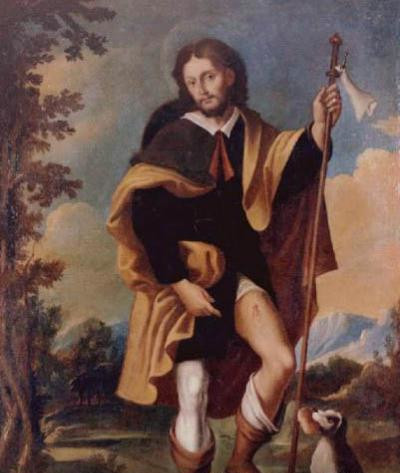
Saint of the Day for 16 August: St Roch
Protector and guide in times of trial
Name
St Roch
Title
Pilgrim and Thaumaturge
Birth
14th century, Montpellier, France
Death
14th century, Voghera, Lombardy
Recurrence
16 August
Martyrology
2004 edition
Canonisation
1414, Council of Constance, Pope Gregory XI
Prayer
Glorious Saint Roch, who through your generosity in consecrating yourself to the service of the plague-stricken and through your continuous prayers saw the pestilence cease and all the infected in Acquapendente, in Cesena, in Rome, in Piacenza, in Mompellier, in all the cities of France and Italy that you travelled through, obtain for us all the grace of being constantly preserved by your intercession from such a frightful and desolating scourge; but much more obtain for us to be preserved from the spiritual plague of the soul, which is precisely sin, so that we may one day be partakers with you of the glory up there in Paradise. So be it.
Patron of
Venezia, Nettuno, Grugliasco, Cisterna di Latina, Segrate, Cernusco sul Naviglio, Villaricca, Gioia del Colle, Triggiano, Mercato San Severino, San Michele Cavana
Protector of
Animals, joints, insurance, dogs, infected, outcasts, (from) epidemics, pharmacists, knees, (from) contagious diseases, health workers, pilgrims, wayfarers, volunteers
Roman Martyrology
In Lombardy, Saint Roch, who, originally from Montpellier in France, acquired a reputation for holiness through his pious wanderings through Italy curing plague victims.
The Saint and Mission
Saint Roch, venerated as the patron saint of the sick and infected, is an extraordinary example of dedication and service to the afflicted. His life, characterised by pilgrimages, care of the sick and miracles, symbolises a mission rooted in compassion and love of neighbour.
Born in France in the 14th century, Saint Roch distinguished himself for his profound spirituality and his commitment to serving those afflicted by the plague, a devastating disease of the time. Despite being infected himself, his faith and dedication did not waver, he continued to care for others and, according to tradition, he miraculously healed thanks to his deep connection with God.
St. Roch’s mission teaches us that serving others, especially in times of great suffering and crisis, is a tangible manifestation of God’s love. His example invites us to look beyond our personal difficulties and dedicate ourselves to a greater mission: that of being instruments of healing and hope in a wounded world. At a time when disease and pandemics continue to challenge society, the figure and mission of Saint Roch remain a source of inspiration for all those who are called to serve and love their neighbour, despite adversity.
The Saint and Mercy
Saint Roch is a shining example of mercy incarnate. His life, marked by loving service to those suffering from the plague, shows how compassionate love can overcome any barrier, even that of fear for one’s health and safety.
When Saint Roch fell ill with the plague during his travels, he never thought of himself, but rather of how he could continue to serve those who were most vulnerable. His ability to see Christ in every sick person and to respond with concrete acts of charity is a powerful reminder of the merciful nature of Christian service. His miraculous healing only strengthened his determination to be a banner of hope for others.
In St Roch, we see mercy not just as a feeling or emotion, but as an action. He reminds us that true mercy does not stop in the face of difficulties or obstacles, but always seeks ways to bring comfort and hope. In a world that often feels overwhelmed by pain and suffering, the story and example of Saint Roch invites us to embrace an active mercy, one that places itself at the service of others with courage and dedication.
Hagiography
Little is known about this Saint, who was one of the most illustrious of the 14th century and one of the dearest to all of Christendom. A native of Montpellier (France), wonderful things are said of his youth. At the age of twenty, bereft of his father and mother, he distributed part of his possessions to the poor and gave part to a paternal uncle. Then, dressed as a pilgrim, he set out begging for money for Rome, to visit the centre of Christianity, the seat of truth and…
